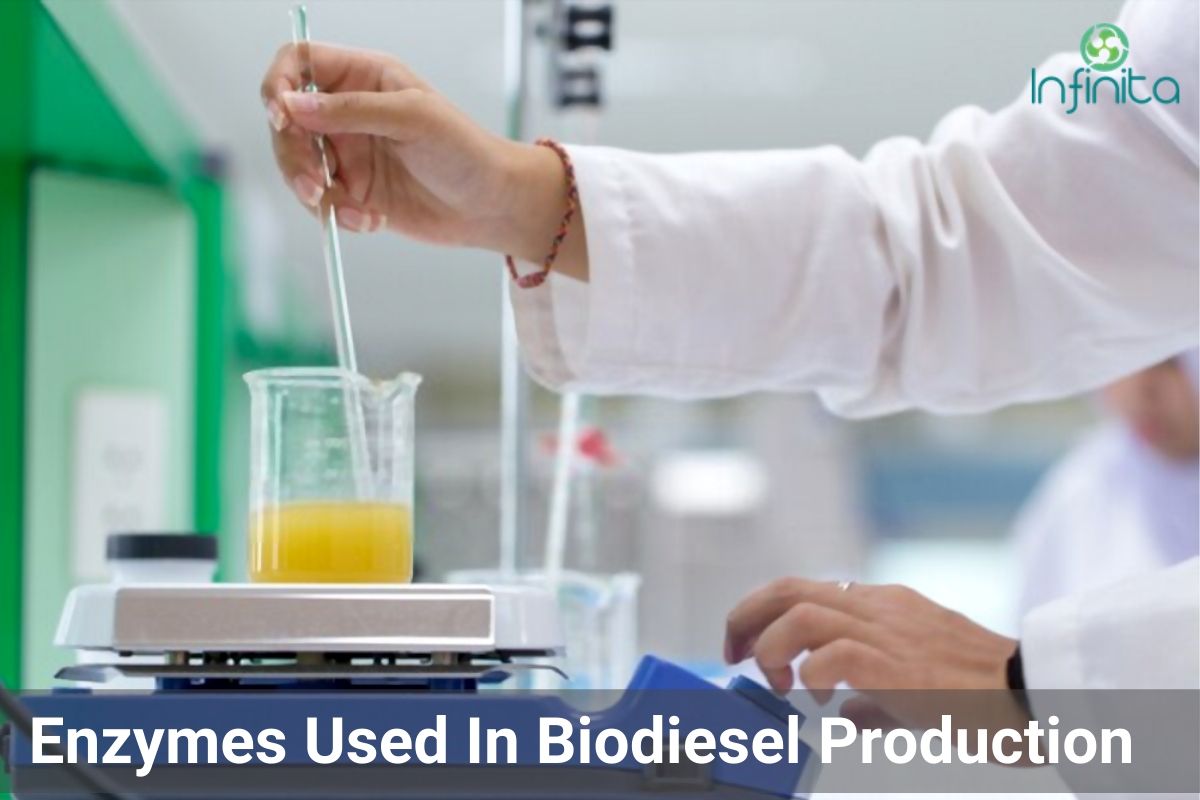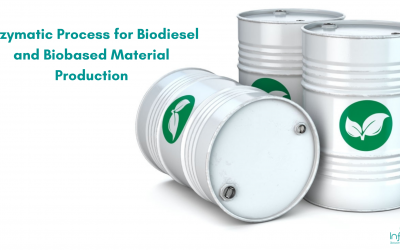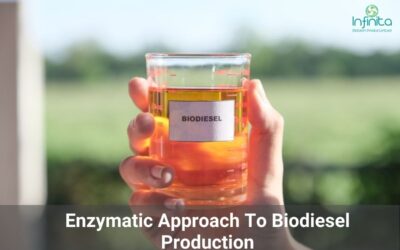
Which Enzymes Are Used In Biodiesel Production?
Enzymes Used In Biodiesel Production
Fluid fuels have been utilized for a long time as the most predominant and fundamental fuel for engine motors. Be that as it may, depleting fossil fuel reserves, and the propensity for developing new sustainable biofuels, have moved the enthusiasm of the general public towards discovering novel alternative fuel sources. Biodiesel (monoalkyl esters of long-chain unsaturated fats) has extraordinary potential as alternative diesel fuel. From an environmental viewpoint, it shows clear favourable circumstances over traditional fuel: it originates from inexhaustible sources and consequently doesn’t add to new carbon dioxide emissions, it is biodegradable, its combustion products have diminished degrees of particulates, sulfur oxides, carbon oxides, nitrogen oxides, and along these lines, essentially decreases pollution. One of the upsides of biodiesel in contrast with different biofuels is that biodiesel can be siphoned, stored and handled utilizing a similar infrastructure utilized for traditional diesel fuel. Likewise, a significant advantage of biodiesel as an alternative fuel is that its energy content is like conventional fuels, so it tends to be utilized either without anything else or blended in with regular diesel fuel, with no need of adjusting existing motors.
There are a few potential procedures for biodiesel blend: pyrolysis, the utilization of microemulsions and transesterification. Through pyrolysis, because of diminished viscosity, gives great quality fuel it despite everything produces more biogasoline than biodiesel fuel. Fuel made by microemulsion makes engine performance issues. Generally, biodiesel is made by transesterification of triacylglycerol (TAG) and short-chain alcohols, ordinarily methanol, with the presence of an acidic or alkaline catalyst. Through this procedure, the flashpoint of biodiesel is brought down and the cetane number is improved. Transesterification is a three-step continuous reaction, in which diglycerides and monoglycerizdes are produced like a middle compound. Three moles of biodiesel and one mole of glycerol are formed for each mole of TAG that experiences total conversion. It is a reversible reaction and the overabundance of alcohol is utilized to move the equilibrium to the products side.
Lipases As Biocatalysts In Biodiesel Production:
Lipases (triacylglycerol hydrolase, EC 3.1.1.3.) are enzymes that catalyze the hydrolysis of carboxylic ester link in the triacylglycerol atom to produce free unsaturated fats, di-and monoglycerides and glycerol. In spite of the fact that their normal capacity is to catalyze the hydrolysis of ester linkages, they can likewise catalyze the esterification, the production of this linkage between alcohol hydroxyl groups and carboxyl groups of carboxylic acids. In this manner, since they can catalyze hydrolysis, alcoholysis, esterification and transesterification they have a wide range of biotechnological applications. Lipases are additionally exceptionally specific as chemo-, regio-and enantioselective catalysts. On account of direct evolution and protein designing it is conceivable to upgrade the reactant capability of lipases and to ‘tailor’ them to the particular application and procedure conditions, empowering further extension of their industrial utility. Among lipases of plant, animal and microbial sources, most popularly utilized are microbial lipases. They have various advantages over lipases from animals and plants. Utilizing microorganisms is conceivable to accomplish a better yield of enzymes and to genetically control the creating strain in getting a minimal cost lipase with desirable properties for the conversion of natural fats and oils into biodiesel.
Reaction framework for lipase is a two-stage system comprising of the aqueous stage with dissolve enzyme and an organic stage with a disintegrated substrate. Lipases have a particular reaction mechanism because of the way that the active site of the catalyst is secured by amphiphilic peptide loop that acts like a lid. This impairs the substrate particle to tie to the active site of the enzyme, causing the negligible activity of lipases in aqueous solutions (without interphase or an organic solvent). At the point when contact happens with a lipid/water interface, the lid experiences a conformational restructuring which renders the active site as accessible to the substrate.
Countless lipase enzymes from various sources have been used for biodiesel production. Candida antarctica B lipase has been the most researched enzyme for biodiesel creation in different reaction frameworks. It catalyzes acyl transfer reactions of different oils and acyl acceptors (alcohols or esters) indicating high stability in natural solvents and expansive substrate specificity. Notwithstanding, the lipase from Pseudomonas has additionally numerous advantages considering enzyme stability in a water-carrying system in the presence of methanol. The lipase from P. cepacia has increased resistance to methanol than those from Rhizopus oryzae, P. roqueferoti, C. lipolytica and even C. antarctica, making it progressively alluring for use as a biocatalyst in methanolysis reaction procedures. Different lipases additionally have been accounted for to be a proficient biocatalyst for the methanolysis response in the solvent-free framework. For instance, an unrefined lipase from the yeast Cryptococcus spp. S-2 productively catalyzed the methanolysis of vegetable oil even in a water-carrying system without an organic solvent and in just one step, keeping away from the stepwise addition of methanol. When all is said and done, lipases delivered from yeast and fungi are most usually utilized because of their low cost and accessibility, albeit a few bacterial lipases, for example, those from Pseudomonas sp., Enterobacter aerogenes, Bacillus subtilis, and others have been altogether examined in view of their unrivalled resistance to methanol. The fundamental quality of lipases for biodiesel creation from triacylglycerols is that they ought to be nonstereospecific with the goal that all tri-, di-and monoglycerides can be changed over to unsaturated fat alkyl esters. It is additionally important that they ought to catalyze the esterification of free unsaturated fats. Furthermore, industrially accessible lipases (Lipozyme, Novozyme) are apparently increasingly suitable catalysts for enormous scale application, since the utilization of free Pseudomonas or different lipases requires the extra immobilization step.
Various factors impact the enzymatic biodiesel production: oil source, reaction temperature, the choice of acyl acceptors, acyl acceptors to oil molar proportion, the measure of water in the reaction or water movement, and presence of organic solvent in the mixture. Ideal parameters for enzymatic transesterification shift contingent upon the source and kind of lipase, sort of oil source, and reactor type. The reaction temperature may fluctuate from 23 to 50°C. One of the key elements of enzymatic ester combination is the water content in the system. Lipases need an ideal small quantity of water to keep up the action in the organic media. All things considered, an increase in the concentration of water unfavourably affects the equilibrium change, since it advances the reverse reaction of hydrolysis. The measure of water in the framework ought to be a trade-off between limiting hydrolysis and augmenting lipase movement for the transesterification reaction and it ought to be determined for a specific reaction system.
The principle advantage of using lipases as biocatalyst are mild reaction conditions and simple recuperation of glycerol without purging or chemical waste production and creation of a high purity item. What’s more unsaturated fats content in the oil can be totally converted over to methyl esters, with no soap production, and hence expanding the biodiesel yield and decreasing the expenses for fuel decontamination.
The creation and utilization of biodiesel will unavoidably ascend in future because of low ecological effect, simplicity of taking care of, and the chance of utilization without the requirement for significant modifications of existing motors of engine vehicles. In spite of the fact that most of the biodiesel makers despite everything utilize a base-catalyzed process, biocatalytic techniques dependent on the action of different microbial lipases offer a few preferences, for example, mild reaction conditions and high selectivity of biocatalysts in correlation with chemical catalysts. These points of interest have great possibilities to cause a huge increment of monetary achievability of biodiesel creation since mild conditions decline energy costs, while high selectivity prompts to avoiding of unwanted by-products formation, less complex downstream processing, and simpler separation of a significant side-product – glycerol.
LIPASE COMPLEX ENZYMES
Our specialised Lipase Complex Enzymes for esterification of edible and non – edible Oils can be utilised to produce biodiesel.

Eco-Friendly

Efficient
Esterification

Highly Specific
Lipase
Related Articles
Enzymatic Process for Biodiesel and Biobased Material Production
Biodiesel as an alternative fuel is gaining demand all over the world due to environmental concerns and depletion of the traditional fossil fuel industry worldwide. But there were concerns like high economic cost in utilizing biodiesel process which can and has been...
Enzymatic Approach To Biodiesel Production
Enzymes In Biodiesel Production With fossil fuels getting extinct, there are alternative ways that are found by scientists and researchers to generate energy that is required to run the world. You must look for the energy sources from where the power can be produced...

Which Enzymes Are Used In Biodiesel Production?
Enzymes Used In Biodiesel Production
Fluid fuels have been utilized for a long time as the most predominant and fundamental fuel for engine motors. Be that as it may, depleting fossil fuel reserves, and the propensity for developing new sustainable biofuels, have moved the enthusiasm of the general public towards discovering novel alternative fuel sources. Biodiesel (monoalkyl esters of long-chain unsaturated fats) has extraordinary potential as alternative diesel fuel. From an environmental viewpoint, it shows clear favourable circumstances over traditional fuel: it originates from inexhaustible sources and consequently doesn’t add to new carbon dioxide emissions, it is biodegradable, its combustion products have diminished degrees of particulates, sulfur oxides, carbon oxides, nitrogen oxides, and along these lines, essentially decreases pollution. One of the upsides of biodiesel in contrast with different biofuels is that biodiesel can be siphoned, stored and handled utilizing a similar infrastructure utilized for traditional diesel fuel. Likewise, a significant advantage of biodiesel as an alternative fuel is that its energy content is like conventional fuels, so it tends to be utilized either without anything else or blended in with regular diesel fuel, with no need of adjusting existing motors.
There are a few potential procedures for biodiesel blend: pyrolysis, the utilization of microemulsions and transesterification. Through pyrolysis, because of diminished viscosity, gives great quality fuel it despite everything produces more biogasoline than biodiesel fuel. Fuel made by microemulsion makes engine performance issues. Generally, biodiesel is made by transesterification of triacylglycerol (TAG) and short-chain alcohols, ordinarily methanol, with the presence of an acidic or alkaline catalyst. Through this procedure, the flashpoint of biodiesel is brought down and the cetane number is improved. Transesterification is a three-step continuous reaction, in which diglycerides and monoglycerizdes are produced like a middle compound. Three moles of biodiesel and one mole of glycerol are formed for each mole of TAG that experiences total conversion. It is a reversible reaction and the overabundance of alcohol is utilized to move the equilibrium to the products side.
Lipases As Biocatalysts In Biodiesel Production:
Lipases (triacylglycerol hydrolase, EC 3.1.1.3.) are enzymes that catalyze the hydrolysis of carboxylic ester link in the triacylglycerol atom to produce free unsaturated fats, di-and monoglycerides and glycerol. In spite of the fact that their normal capacity is to catalyze the hydrolysis of ester linkages, they can likewise catalyze the esterification, the production of this linkage between alcohol hydroxyl groups and carboxyl groups of carboxylic acids. In this manner, since they can catalyze hydrolysis, alcoholysis, esterification and transesterification they have a wide range of biotechnological applications. Lipases are additionally exceptionally specific as chemo-, regio-and enantioselective catalysts. On account of direct evolution and protein designing it is conceivable to upgrade the reactant capability of lipases and to ‘tailor’ them to the particular application and procedure conditions, empowering further extension of their industrial utility. Among lipases of plant, animal and microbial sources, most popularly utilized are microbial lipases. They have various advantages over lipases from animals and plants. Utilizing microorganisms is conceivable to accomplish a better yield of enzymes and to genetically control the creating strain in getting a minimal cost lipase with desirable properties for the conversion of natural fats and oils into biodiesel.
Reaction framework for lipase is a two-stage system comprising of the aqueous stage with dissolve enzyme and an organic stage with a disintegrated substrate. Lipases have a particular reaction mechanism because of the way that the active site of the catalyst is secured by amphiphilic peptide loop that acts like a lid. This impairs the substrate particle to tie to the active site of the enzyme, causing the negligible activity of lipases in aqueous solutions (without interphase or an organic solvent). At the point when contact happens with a lipid/water interface, the lid experiences a conformational restructuring which renders the active site as accessible to the substrate.
Countless lipase enzymes from various sources have been used for biodiesel production. Candida antarctica B lipase has been the most researched enzyme for biodiesel creation in different reaction frameworks. It catalyzes acyl transfer reactions of different oils and acyl acceptors (alcohols or esters) indicating high stability in natural solvents and expansive substrate specificity. Notwithstanding, the lipase from Pseudomonas has additionally numerous advantages considering enzyme stability in a water-carrying system in the presence of methanol. The lipase from P. cepacia has increased resistance to methanol than those from Rhizopus oryzae, P. roqueferoti, C. lipolytica and even C. antarctica, making it progressively alluring for use as a biocatalyst in methanolysis reaction procedures. Different lipases additionally have been accounted for to be a proficient biocatalyst for the methanolysis response in the solvent-free framework. For instance, an unrefined lipase from the yeast Cryptococcus spp. S-2 productively catalyzed the methanolysis of vegetable oil even in a water-carrying system without an organic solvent and in just one step, keeping away from the stepwise addition of methanol. When all is said and done, lipases delivered from yeast and fungi are most usually utilized because of their low cost and accessibility, albeit a few bacterial lipases, for example, those from Pseudomonas sp., Enterobacter aerogenes, Bacillus subtilis, and others have been altogether examined in view of their unrivalled resistance to methanol. The fundamental quality of lipases for biodiesel creation from triacylglycerols is that they ought to be nonstereospecific with the goal that all tri-, di-and monoglycerides can be changed over to unsaturated fat alkyl esters. It is additionally important that they ought to catalyze the esterification of free unsaturated fats. Furthermore, industrially accessible lipases (Lipozyme, Novozyme) are apparently increasingly suitable catalysts for enormous scale application, since the utilization of free Pseudomonas or different lipases requires the extra immobilization step.
Various factors impact the enzymatic biodiesel production: oil source, reaction temperature, the choice of acyl acceptors, acyl acceptors to oil molar proportion, the measure of water in the reaction or water movement, and presence of organic solvent in the mixture. Ideal parameters for enzymatic transesterification shift contingent upon the source and kind of lipase, sort of oil source, and reactor type. The reaction temperature may fluctuate from 23 to 50°C. One of the key elements of enzymatic ester combination is the water content in the system. Lipases need an ideal small quantity of water to keep up the action in the organic media. All things considered, an increase in the concentration of water unfavourably affects the equilibrium change, since it advances the reverse reaction of hydrolysis. The measure of water in the framework ought to be a trade-off between limiting hydrolysis and augmenting lipase movement for the transesterification reaction and it ought to be determined for a specific reaction system.
The principle advantage of using lipases as biocatalyst are mild reaction conditions and simple recuperation of glycerol without purging or chemical waste production and creation of a high purity item. What’s more unsaturated fats content in the oil can be totally converted over to methyl esters, with no soap production, and hence expanding the biodiesel yield and decreasing the expenses for fuel decontamination.
The creation and utilization of biodiesel will unavoidably ascend in future because of low ecological effect, simplicity of taking care of, and the chance of utilization without the requirement for significant modifications of existing motors of engine vehicles. In spite of the fact that most of the biodiesel makers despite everything utilize a base-catalyzed process, biocatalytic techniques dependent on the action of different microbial lipases offer a few preferences, for example, mild reaction conditions and high selectivity of biocatalysts in correlation with chemical catalysts. These points of interest have great possibilities to cause a huge increment of monetary achievability of biodiesel creation since mild conditions decline energy costs, while high selectivity prompts to avoiding of unwanted by-products formation, less complex downstream processing, and simpler separation of a significant side-product – glycerol.
0 Comments
Submit a Comment
You must be logged in to post a comment.
LIPASE COMPLEX ENZYMES
Our specialised Lipase Complex Enzymes for esterification of edible and non – edible Oils can be utilised to produce biodiesel.

Eco-Friendly

Efficient Esterification

Highly Specific Lipase
Enzymatic Process for Biodiesel and Biobased Material Production
Biodiesel as an alternative fuel is gaining demand all over the world due to environmental concerns and depletion of the traditional fossil fuel industry worldwide. But there were concerns like high economic cost in utilizing biodiesel process which can and has been...
Enzymatic Approach To Biodiesel Production
Enzymes In Biodiesel Production With fossil fuels getting extinct, there are alternative ways that are found by scientists and researchers to generate energy that is required to run the world. You must look for the energy sources from where the power can be produced...



0 Comments